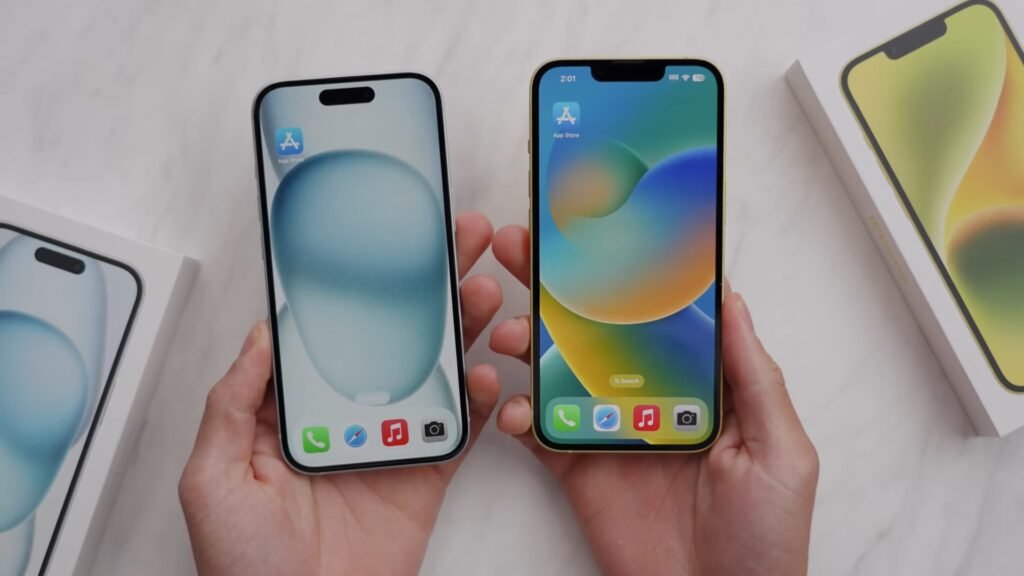Today I’m here to give you a detailed and comprehensive comparison and review of the latest addition to the Apple iPhone lineup, the iPhone 15, alongside its predecessor, the iPhone 14. The burning question on everyone’s mind is whether it’s worth the upgrade or even worth getting in the first place. Let’s dive in and find out.
Design Evolution or Stagnation?
Let’s start with the design, an area where Apple has been known for its timeless aesthetics. Looking at the front of both the iPhone 15 and iPhone 14, it’s clear that Apple’s design philosophy remains consistent. The notch and general form factor of both devices are strikingly similar. They share the same thickness, with a mere one-gram difference, although the iPhone 15 does feel a tad lighter. What sets them apart is the introduction of Dynamic Island, a feature previously exclusive to the Pro models, which has now made its way into the iPhone 15.
Dynamic Island, a feature first seen in the iPhone 14 Pro, is now available in the standard iPhone 15. While not a revolutionary change, it does add a layer of interactivity to the device. Dynamic Island offers quick access to notifications, providing a more dynamic and informative lock screen experience. If you’ve grown accustomed to this feature on the Pro models, its inclusion in the iPhone 15 may sway your decision.
Aesthetic Improvements
Apple has also made changes to the aesthetics of the iPhone. The iPhone 15 features a more pastel and muted color scheme infused into the back, reducing the visibility of fingerprints compared to the glossier finish of the iPhone 14. While many users opt for protective cases, those who prefer the naked feel of their phones will appreciate the reduced smudging on the iPhone 15. It’s a subtle but welcome improvement for those who are particular about the appearance of their devices.
Display Upgrades
Moving on to the displays, there are subtle yet significant differences between the iPhone 15 and its predecessor. The iPhone 15 boasts around 120 more pixels than the iPhone 14, offering a brighter screen with a peak brightness of a thousand to two thousand nits compared to the 800 to 1200 nits on the iPhone 14. The higher peak brightness of the iPhone 15 is particularly noticeable when you’re using the phone outdoors in direct sunlight.
Another notable difference in the display is the color temperature. The iPhone 14 tends to have warmer and yellower tones, whereas the iPhone 15 leans towards a cooler, bluish hue. Display preferences can be highly subjective, so this change might appeal to those who prefer cooler displays, but it’s worth noting that color temperature can be adjusted in the settings.
It’s important to mention that both devices still feature a 60Hz refresh rate. For those seeking a smoother experience with higher refresh rates, you’ll need to opt for the Pro models. The absence of ProMotion in the standard models may disappoint some users, but for most daily tasks, both the iPhone 15 and iPhone 14 provide super quick and snappy performance.
The Shift to USB-C
One of the most significant changes in the iPhone 15 is the adoption of USB-C, a move that has been long-awaited by many Apple users. While not revolutionary in the broader tech world, this standardization of cables is a welcome change. USB-C offers faster data transfer speeds and supports a wide range of peripherals, making it a versatile choice.
However, this change does raise questions for those with a collection of Lightning accessories. If you’ve invested in Lightning-compatible accessories such as AirPods Pro 2, you may now need to carry multiple cables for different devices. This transition might be a minor inconvenience for some users, but it’s a step towards standardization that could benefit Apple’s ecosystem in the long run.
Performance and Chipsets
Moving to the performance department, things get a bit more complex. The iPhone 15 packs the A16 Bionic chip, while the iPhone 14 uses the A15 Bionic. On paper, the A16 might seem like a substantial leap forward, but the real-world difference in performance is less noticeable. Both devices offer snappy and responsive performance for everyday tasks, and you’ll likely find that apps open quickly and multitasking is a breeze on both models.
The iPhone 15 does shine in its Pro models with a higher refresh rate, offering a smoother and more responsive user experience. However, for these standard models, the upgrade in the chipset may not be a game-changer. If you’re coming from an older iPhone or have more budget-conscious priorities, the iPhone 14 still offers solid performance for most users.
The Camera Revolution
Perhaps the most significant upgrade comes in the form of the camera. The iPhone 15 sports a 48-megapixel sensor, a substantial leap from the 12-megapixel sensor used in the iPhone 14. This marks the first significant sensor upgrade in the standard iPhone line in seven years. The higher megapixel count allows for better cropping and more flexibility in telephoto shots.
The primary advantage of the 48-megapixel sensor is its ability to capture more detail, making it a game-changer for photography enthusiasts. If you frequently rely on your smartphone for photography, whether for personal or professional use, the iPhone 15’s camera upgrade alone might be enough to sway your decision. The camera improvements aren’t limited to still photos; video enthusiasts will also appreciate the enhanced capabilities.
Both devices still feature a 12-megapixel Ultra Wide lens, but the added bonus of the 48-megapixel sensor on the iPhone 15 allows for more creative freedom. You can now crop in two times for a telephoto effect, offering more versatility in your photography.
One of the standout features of the iPhone 15’s camera system is the new and improved Portrait mode. Apple dedicated a significant portion of its keynote presentation to this feature, highlighting its capabilities. When a human or even a furry friend like a dog enters the frame, you’ll notice a little “F” icon appearing on the camera app. This feature allows you to adjust the level of background blur (bokeh) and select the area in focus in post-processing. It’s a software update tied to iOS 17 and is also available on older iPhones, so it’s not exclusive to the iPhone 15.
Pricing Considerations & Conclusion
Finally, let’s talk about pricing. The iPhone 14 has seen a $100 drop in price, making it an attractive option at $699 (in the U.S.), compared to the iPhone 15’s $799 price tag. This price reduction might be the deciding factor for many users, as it represents a significant saving while still offering a powerful and capable device.
So, the iPhone 15 brings several improvements to the table, but whether it’s worth upgrading from the iPhone 14 depends on your priorities. If you are a photography enthusiast, the camera upgrade alone makes the iPhone 15 a compelling choice. The enhanced display brightness, USB-C support, and improved aesthetics are also factors to consider.
However, for users not obsessed with the latest camera tech or who have older iPhones, the iPhone 14 still offers a solid and more budget-friendly option. Its lower price tag, coupled with the minor differences in performance and design, make it an attractive choice.
As always, tech decisions boil down to individual preferences and needs, so consider what matters most to you when making your choice. Whether it’s Dynamic Island, the camera, or the promise of standardized cables, Apple continues to deliver on its commitment to innovation and user experience.
Stay tuned for more tech insights, and make sure to subscribe for future updates on Apple’s latest products. Peace!


